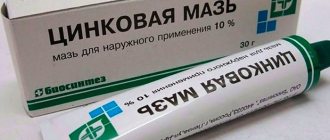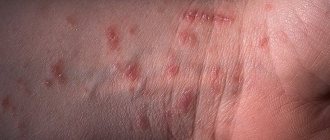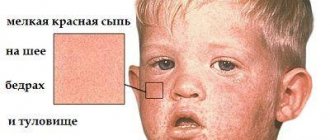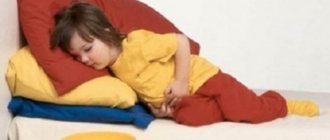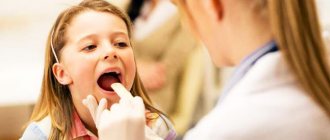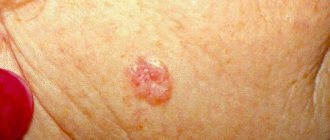Flowering in newborns is a special type of hormonal rash in infants. It is characterized by a red rash on the baby's face. This rash is not dangerous and can go away on its own without additional drug treatment.
But new parents, caring for their little child, rush to the hospital demanding immediate action, fearing that the rash will be contagious or threaten their health. And an inexperienced or inattentive pediatrician may confuse the symptoms of a hormonal rash with an allergic reaction, dermatitis and other types of rash. An erroneous diagnosis leads to the prescription of numerous medications that not only will not help, but will also harm the child’s fragile body.
What is newborn bloom
Baby bloom or, scientifically, neonatal cephalic pustulosis looks like small red or white pimples on the skin of the neck, cheeks, buttocks, and forehead. Acne in newborns occurs due to underdevelopment of the sebaceous glands. When signs of flowering appear, characterized by red or white pimples, many parents panic, but this is not necessary. Infant acne goes away on its own as soon as the body's primary reaction to its own or maternal hormones is normalized.
Preventing neonatal acne
To reduce rashes, you should not violate the rules of hygiene and provide your baby with more fresh air. Less walking under the influence of sunlight, as during hot weather the activity of the sebaceous glands is activated.
To keep your baby's skin in perfect condition, you need to follow some measures to prevent skin rashes.
During the period of acne formation in newborns, the mother is quite capable of monitoring the child’s condition and taking proper care of him, carrying out all the required hygiene procedures. To properly care for your baby’s delicate skin, you should follow a number of steps:
- Keep children's skin clean. Wash your child every day, but do not rub areas where acne has accumulated. Wash your child using baby soap at least 2 times a day;
- bathe your baby using only baby bath products;
- do not use any ointments or alcohol solutions without medical advice; It is allowed to wipe your face in the morning with decoctions of chamomile, string or calendula;
- An alternative to decoctions can be cotton pads, previously soaked in soapy water, for wiping the face;
- reddened pimples can also be lubricated with Panthenol;
- The child must have an individual towel;
- do not allow direct sunlight to fall on the baby’s face;
- need to walk outdoors more often
- an open scratch is a recipe for infection. For this reason, make sure that your child does not scratch pimples. We remind you that the nails on babies’ arms are trimmed once every 5 days, and on their legs – once every 10 days.
- Air baths are not only an excellent method of hardening, but also prevent the occurrence of rashes and inflammations on the skin of babies.
- The baby's clothes should be made only from natural materials, but preferably with external seams, spotlessly clean and ironed. This also applies to his bedding.
- The room where the crib is located must maintain a suitable humidity and temperature for the child. The heat in the room is unacceptable!
- If reddish spots appear on the baby’s body and the skin begins to itch, be sure to show the baby to the doctor.
It is not easy to fully protect yourself from acne in newborns. But precautions significantly reduce the risk of purulent pimples and rashes in children.
Neonatal cephalic pustulosis or neonatal acne is a normal occurrence, for this reason parents do not need to get upset or panic. Hormonal rash goes away on its own after a certain time. Therefore, you just need to have a little patience and your baby’s acne will go away on its own.
Symptoms
Flowering in children occurs during the period after birth and can last up to six months of age. In the photo, acne looks like a scattering of small inflamed pimples with purulent contents or redness, which appear as similar processes on the skin of adolescents, that is, with the next hormonal changes. Pustulosis does not cause discomfort to babies and does not harm the child’s body. The problems go away as soon as the sebaceous glands begin to function fully. Pediatricians prescribe treatment only for severe manifestations.
What is prohibited for skin rashes?
The mechanism of acne in children, as in adults, is the same: most often it is an inflammation of the ducts of the sebaceous glands. Flowering of newborns can be noticed at about 2-3 weeks of life, the skin rashes finally disappear by three months. Sometimes such a hormonal rash develops even in the prenatal period, and the baby “blooms” until about 6 months, and in severe manifestations - up to a year.
There is a great temptation for parents to solve the problem of pustular rashes or closed comedones mechanically - take it and squeeze it out. A categorical NO! You will increase the area of skin rashes, resulting in entire colonies of papules on the baby’s face. From here there is a direct path to a pediatric dermatologist and long-term treatment.
When the pediatrician has confirmed the diagnosis of newborn acne, forget about oils and lotions for baby’s skin care. Also included in the prohibited category are:
- brilliant green;
- potassium permanganate solution;
- iodine;
- antibiotic-based ointments;
- powders;
- hormonal creams.
By following simple recommendations, following common sense and our advice, you will safely pass the dangerous period of “blooming” and the occurrence of acne in your baby.
Remember - only the first six months of a baby’s life can lead to acne problems. Late manifestations of skin rashes are symptoms of other diseases in infants. Timely contact with specialists will restore your child’s health!
How to distinguish it from other diseases?
Attentive parents, according to Komarovsky, are quite capable of independently figuring out what exactly has popped up on the baby’s skin—neonatal pimples or allergy rashes. In case of a food or other allergic reaction, the rash will appear on the entire body; in case of newborn acne, the rash will appear only on the face.
And now Dr. Komarovsky himself will tell us what childhood acne is, how this disease is explained and the rules of proper skin care.
An allergic rash, as a rule, gives the child a lot of unpleasant sensations: it itches, itches, the baby begins to behave restlessly, be capricious, and cry for no apparent reason. Newborn acne does not cause any intrusive or unpleasant effects, the child does not feel it.
Acne in babies can be in the form of papules (reddish lumps), comedones (whitish, seemingly “closed” rash) or pustules (reddish lumps with a light top, pus). With an allergic rash, the rashes and the areas around them have a pronounced red tint, without purulent “heads” or whitish tops.
Dr. Komarovsky recommends that when a rash is detected, carefully look at that part of the child’s bottom that is always hidden under the diaper. It does not come into contact with any allergens, and therefore if there is no rash there, then there is no point in talking about food allergies. If it is, then we are most likely not talking about harmless pimples, but a real allergic reaction.
We present to your attention another interesting thematic episode of Dr. Komarovsky’s program.
Sometimes acne is confused with prickly heat. If the baby is wrapped up and daily bathing is neglected, then the rash on the face will actually initially resemble acne (this disease is also called facial discoloration). You can distinguish it by its prevalence - miliaria spreads throughout the body faster than acne, and, as a rule, does not have purulent heads.
Even more often, acne can be confused with dermatitis. Only a doctor can determine the difference, and therefore Komarovsky recommends that in any case, show the baby to a pediatrician.
What does flowering look like for a baby?
If you have any suspicious spots or pimples on your child’s skin, you should consult a doctor; you cannot make a diagnosis yourself. Babies are susceptible not only to infant bloom, but also to many other skin diseases, including seborrheic dermatitis, eczema, and milia. Also, a child may have an allergy, and it is very similar to flowering; we will tell you how to distinguish it further.
Flowering is characterized by:
- The appearance on the baby’s face of small reddish pimples, inside of which pus is noticeable. Particularly severe rashes are often found on the forehead, nose, and cheeks. Less common is a rash on the scalp. Even less often - on the back, neck, chest.
- Infants begin to bloom at an early age, most often the rash appears between the 2nd and 4th week of birth.
- When the baby is restless, pimples are more noticeable.
- After pimples, peeling is observed.
Young parents, examining the skin of their child, begin to doubt whether it is a bloom or an allergic reaction. Both conditions appear very often in children under six months of age and are very similar in appearance. How to distinguish them?
- Both allergies and flowering mostly affect the face. But in the first case, there will be more rashes on the cheeks, while the bloom is concentrated mainly in the center of the face.
- Both conditions have a reddish tint. Childhood acne is not itchy reddish pimples, but allergies are swollen rashes that cause itching; the child is constantly capricious, as this condition bothers him. The baby loses appetite and may develop diarrhea. If this is the case, then contact your pediatrician as soon as possible.
There is a photo of flowering in infants in the publication, and you can see what the skin looks like. Allergies are very easy to distinguish; you just have to visually compare both conditions.
If you have any doubts, do not delay a visit to a therapist or dermatologist, who will be able to tell you exactly what the problem is.
Reasons for appearance
The main reason for this rash is hormonal. It is called differently: pustulosis, acne, milia. Outwardly, such rashes resemble small millet specks, pale red in color, with minor white inclusions.
Sometimes such a rash occurs in a baby during fetal development. And it can last longer than six months, and occasionally, until the end of the child’s first year of life.
Important to remember! Such skin rashes are caused by the production of hormones and do not cause any harm to the small organism. .
Therefore, it is very important not to confuse such a rash with various types of dermatitis and allergic reactions that require drug treatment or nutritional correction. After all, an incorrect diagnosis and incorrectly prescribed treatment will not only not help, but will also harm a small, fragile organism.
Flowering will go away on its own, without any medical interventions, when the child’s body adapts to new living conditions, and when the gastrointestinal tract adapts to produce beneficial microflora.
The main culprit of such a rash is estrogen - the female sex hormone. This is a maternal hormone, and breastfeeding produces it in the child’s body. The presence of this hormone in the baby causes increased activity of the sebaceous glands, which is manifested by a rash on the face. You just need to wait out this period, the child’s body will adapt, and the rash will go away on its own. This condition is normal for the development of a small organism, so parents should not worry or worry about this.
Treatment of hormonal rash
Typically, skin bloom appears on the baby’s face a few days after the little person is born, lasts quite a long time: from 20 days to 3 months, and goes away on its own.
But often young and responsible parents, when such a rash appears in a newborn, begin to sound the alarm and rush to doctors, in search of a miracle cure.
As mentioned above, such an anomaly does not pose any harm to the health of the little man. And the child’s body itself, having adjusted and adapted to new living conditions, will begin to slowly remove the hormone estrogen, without any outside intervention. Hormonal rashes do not bother the child, do not cause itching or any discomfort.
If the baby is diagnosed with bloom (acne, neonatal cephalic pustulosis), then you can calm down and just wait for the child’s skin to become pink, smooth, and beautiful again! No treatment is required.
Many mothers, trying to speed up the baby’s “recovery” process, begin to engage in amateur activities and make mistakes. Which? We'll tell you further.
Advice from Dr. Komarovsky
As we have already said, no special treatment is required for acne in a newborn, but there are some nuances that Evgeniy Olegovich recommends that all young mothers learn and learn.
- Squeezing pimples on a baby is strictly prohibited! Firstly, it hurts, and secondly, pathogenic bacteria can get into the wounds and cause an inflammatory process. Then, in place of such “complicated” wounds, ugly scars will remain, which are no longer possible to get rid of.
- If parents use cosmetics for children, they should be labeled “From the first days of life.” There is no need to burn acne with brilliant green, iodine, alcohol or alcohol-containing solutions. Antibiotic ointments and even regular baby cream are prohibited, because they are quite greasy. Don't try to solve the problem with powder, it's useless. If there are a lot of rashes, you can use zinc ointment or Sudocrem; they effectively “dry out” the pimples.
- If the acne does not go away for a long time, the rash becomes larger and more and more areas of the baby’s face are covered with it, be sure to consult a doctor. Such pimples may not have a hormonal root cause, but an infectious one.
- A mother who is breastfeeding should worry less so that the stress hormone cortisol does not enter the milk. It also contributes to the appearance of skin problems in the child. In addition, a nursing mother should reconsider her diet.
- A child with newborn acne needs sun and air baths and hardening. In the warm season, a baby with problem skin should be outdoors more often. Phytotherapy is acceptable - bathing in water with the addition of a decoction of chamomile and string. You can wash your baby with chamomile several times a day, avoiding getting the decoction in the eyes, nose and ears.
- With the right approach, according to Evgeniy Komarovsky, acne goes away without a trace on its own in a fairly short time - from several weeks to 3 months.
Rules for a nursing mother
If a baby has a bloom on his face (you can evaluate the photo of the condition above), then to speed up his recovery you need to start following a diet, of course, if breastfeeding is used. Avoid fatty foods and unhealthy foods (salted, smoked foods included). Drink plenty of water, as it cleanses the body of toxins (which can be passed on to the baby through milk), and eat permitted fruits.
In order not to worry once again about a rash in a baby, a nursing mother should adhere to the following recommendations:
- During breastfeeding, mothers are strictly prohibited from taking any hormonal medications. If there is an urgent need for this, you should seek help from specialists and take medications only with a doctor’s prescription, eliminating all possible risks for the baby.
- During breastfeeding, be sure to follow a diet; nutrition should be balanced and bring maximum benefit to the newborn and mother.
- It is imperative to monitor the baby’s hygiene. Bathe him, wash him, and prevent excessive sweating. In water procedures, use only warm, clean water. You should dry the baby with a soft towel, only lightly blotting the baby’s delicate skin. Use only proven hypoallergenic products for infant personal hygiene.
- For bathing, you can use a weak herbal decoction. Chamomile and string have proven themselves well.
- The mother should refrain from taking medications during the feeding period. And if it is vitally necessary, be sure to consult a competent doctor.
In order for a child to grow up healthy, it is strictly forbidden to self-medicate. A child’s skin is very delicate and sensitive, and if the treatment is not chosen correctly, complications and scars in the form of pockmarks are possible, which can remain for life.
How to distinguish flowering from allergies in a newborn
Since many infants suffer from allergies, it is important to be able to distinguish one from another in case of skin rashes. Phenomena look different both in photos and in life. The ability to distinguish allergies when pimples appear is important for making an independent preliminary diagnosis, understanding whether the baby needs to be shown to a pediatrician, or whether everything will work out using simple home remedies. The rules are as follows:
- An allergic rash is caused by specific foods, so it manifests itself abruptly, within a few minutes or hours.
- Acne does not cause discomfort in a newborn; manifestations of allergies can be accompanied by itching, pain, which causes crying, and poor appetite in the baby.
- The appearance of pustulosis looks like small pustules that can be carefully cleaned with a cotton swab dipped in a disinfectant solution.
- Acne in newborns goes away on its own after a few months, chronic allergies and diathesis continue to cause inconvenience.
What to do if a child blooms
Specific treatment is prescribed only for extensive rashes and severe suppuration. You can improve the condition of a newborn’s skin by observing hygiene standards and adjusting the mother’s diet. The main method of prevention is to regularly bathe the baby, followed by treating acne-prone areas with baby cream. Do not do anything else without specific instructions from your pediatrician.
Mom's nutrition
The mother's diet is important for the baby. Blooming of the skin of newborns can be reduced or completely eliminated by excluding certain foods that affect the level of specific hormones that provoke the active functioning of the sebaceous glands. During lactation, women are advised to adhere to certain daily diet restrictions.
- Eliminate fatty foods and fast food.
- Limit sweets, especially honey and chocolate - they tend to provoke acne.
- Drink at least two liters of clean water per day.
- Use juices, citrus fruits, and exotic fruits with caution.
How to understand that a baby has not an allergy, but a bloom?
Experts are inclined to argue that this condition of children is associated with hormones transferred from the mother at the end of pregnancy. These hormones stimulate the sebaceous glands, which is how the rash appears. Gradually, the level of transmitted hormones decreases, the baby’s skin condition returns to normal, and soon the parents receive a ruddy baby with perfect clean skin!
The mother herself can intensify flowering if she does not follow a special diet and hygiene during breastfeeding. In addition to flowering, a child may develop various skin diseases caused by fungi and pathogenic bacteria due to lack of hygiene. If the diet is not maintained, acne appears.
Yet flowering is much more common than skin diseases. Allergies are the second most common and can easily be mistaken for a bloom. If the latter condition does not pose a threat to the life and health of the baby, then the first one needs to be recognized faster and get rid of it. Next, we’ll learn how to distinguish flowering from allergies in infants.
Traditional methods of treatment
Infant acne is the case when most pediatricians recommend using folk remedies instead of potent medications. Since the condition is not pathological, after differentiating the diagnosis from more dangerous diseases (allergies, measles), doctors advise using herbal medicine. The most effective methods:
- Chamomile baths. Cook a teaspoon of dry collection for half an hour in a steam bath. Add three to four tablespoons of broth while bathing the child.
- A decoction of the string. Steam two teaspoons of the collection for thirty minutes, then add three to five tablespoons to an infant’s bath when bathing.
- Jojoba oil. Apply three to four drops to a cotton swab and lubricate the reddened areas. Should not be used for a long time, there is a risk of causing allergies.
Treatment and prevention
There is an excellent “calming” for parents: if a child is diagnosed with acne, it will go away on its own, it does not need to be treated. The baby will “outgrow the problem”, the mother will improve her diet and lifestyle. Your baby will delight you with clean, soft, smooth skin 3-4 weeks after identifying the problem with infant acne.
You can do without treatment if you follow certain rules:
- start with yourself, mommies: we recommend a proper diet, a healthy lifestyle, an optimistic attitude;
- carefully care for the delicate skin of a newborn - daily bathing in boiled or running water;
- already now the sun, air, water;
- maintain an active motor mode for the baby.
Air baths are a must for maintaining healthy skin and getting rid of acne. They need to be done daily
Characteristic signs
This anomaly is recognized by characteristic small pimples, pale red in color, with a whitish or yellowish center.
Such acne can be isolated, or it can be entire lesions. This rash most often occurs on a child’s face, but can also occur on the scalp, shoulders, arms, neck, back, and abdomen. In boys, sometimes blooms even appear on the penis.
This rash can easily be confused with an allergic reaction, which is also quite common in children. To rule out an allergy, it is necessary to carefully review the mother’s diet, whether there are any new food additives or medications.
If there were no prerequisites for allergic rashes, then we can confidently say that this is an infant bloom.
Important point! To distinguish blooms from other dermatitis and diathesis, it is necessary to check acne for peeling. The hormonal rash does not peel off and does not contain even the smallest scales.
Causes of skin discoloration in newborn babies
Everyone is likely to experience the phenomenon of flowering in newborns.
There is no need to worry too much if you find pimples on your baby’s body; such a mild disease will not be fraught with complications. But you shouldn’t let the illness go unnoticed, it still doesn’t correspond to the norm, and if you don’t apply the proper treatment procedures, it can affect the baby’s health.
Hormonal imbalance. This case is characterized by short-term hormonal imbalance. The most likely cause is breastfeeding. Mother's milk transports hormones into the baby's body, which leads to an overabundance of a certain element. Boys are most susceptible to this influence.
Overactivity of the sebaceous glands. Sometimes the occurrence of flowering serves as a signal that the sebaceous glands are too active. It is explained by the individuality of the organism and does not pose any threat. This happens most often in girls.
Violation of hygiene rules. This reason follows from the previous one. After all, the sebaceous glands actively secrete lubricant, which covers the child’s face with a film and accumulates dust, clogs pores, and becomes a breeding ground for microbes. When the oily film is not removed, acne appears on the baby's face.
Reaction to nutrition. Mother's milk often contains certain substances that cause flowering. Therefore, nursing mothers need to be especially careful about what they eat during lactation.
During the period of intrauterine development of your baby, you shared with her many valuable substances in your body, including hormones. Now they come to her through breast milk. As a result of an excess of these, already foreign, biologically active substances, newborns develop a hormonal rash.
- Immaturity of the gastrointestinal tract (which may be accompanied by digestive disorders in an infant. Read the current article: Loose stools in infants{amp}gt;{amp}gt;{amp}gt;;
While still in the stomach, the baby received nutrition from you through the umbilical cord. Now you are breastfeeding him (related article: Breastfeeding{amp}gt;{amp}gt;{amp}gt;). One way or another, the child is forced to get used to a new type of nutrition.
“Blooming” in medicine is called an adaptive allergy. That is, during this period you still need to take a more careful approach to your diet. Do not aggravate the child's condition.
To eat properly and safely for your baby, watch the online seminar Nutrition for a nursing mother without harm to the baby{amp}gt;{amp}gt;{amp}gt;. In it you will receive a nutrition plan if you suspect an allergy and we will analyze in detail the differences between childhood skin rashes.
By eating safely, you make the work of the child’s body easier. After all, in fact, there are no allergens and there is no need to “fight the enemy” either. Your baby's skin will clear up faster.
- Excessive activity of the sebaceous glands;
This reason is typical for acne. It can be triggered by the same hormones. Most often, flowering from this occurs in girls.
In principle, none of these reasons indicates the presence of any abnormalities in the newborn’s body. Therefore, flowering in infants is considered a physiological norm, which is characteristic of the process of adaptation and purification that occurs during the newborn period.
Treatment options
What can be done to cure such rashes? To cure your baby of rashes, you do not need to resort to non-standard treatments or take medications. To cure, it is enough to follow the general instructions.
The pediatrician will specifically explain and give clear recommendations on what needs to be done specifically for your baby. You need to go for a consultation, because home treatment can provoke unforeseen complications.
First of all, while carrying a child and feeding him, you need to stop using hormonal drugs. If you have a serious illness, then only the attending physician is obliged to regulate the use of such drugs. The baby’s health also needs to be monitored.
What not to do
It is necessary to clearly understand what cannot be done in case of such a disease in a newborn. Firstly, don’t even try to restore your baby’s hormonal balance yourself. These actions can cause a malfunction in the functioning of some organs. The baby’s body will cope on its own; there is no need to interfere.
Medicines have a very negative effect on the body of a newborn. Especially when there is talk about their uncontrolled use. There is a strict ban on treating a baby's skin with oil-based anti-acne ointments. With their assistance, an airtight film is formed, and the disease begins to progress. You can only use those medications prescribed by your pediatrician.
You should not try to mechanically remove pimples; damage may occur on the baby’s skin, which will serve as a gateway for infections. Use drying agents carefully and try not to rub the affected area during treatment.
- It is strictly not recommended to use hormonal medications on your own to try to quickly normalize the hormonal levels in a newborn. Such an intervention will do nothing but harm to his body;
- Another prohibition is that you cannot squeeze or try to remove pimples using other mechanical methods. This may lead to skin irritation or inflammation;
- You should not, without a doctor’s prescription, use various ointments and creams (even if they are intended to combat acne), alcohol solutions or tinctures.
Remember that flowering is not at all dangerous for the baby and does not bother him at all!
If you remain calm and do not self-medicate, the problem will disappear quickly and unnoticed even without external intervention.
What is it, symptoms of manifestation
What exactly is newborn bloom? Thus, one of the diseases that belongs to the dermatological branch manifests itself. In fact, this is the name of the rash on the body of a small child. Such symptoms are commonly called acne. Mild acne most often appears on the cheeks of the baby.
The presence of a problem in a newborn is indicated primarily by the following symptoms:
- The child's face becomes covered with acne. In addition, the baby's head and neck may be affected.
- The skin takes on a reddish tint and sometimes yellow, whitish and pink spots appear on it.
- A rash also appears on the child’s body, but it is not as pronounced and smaller than on the head.
No itching or discomfort. The baby does not show any concern about the manifestation of malaise. The sebaceous glands function intensely, and a light film of fat appears on the baby’s face.
The appearance of similar symptoms is a reason to visit a doctor. Do not even think about using traditional medicine or medications on your child uncontrolled; first consult a doctor to clarify the diagnosis.
